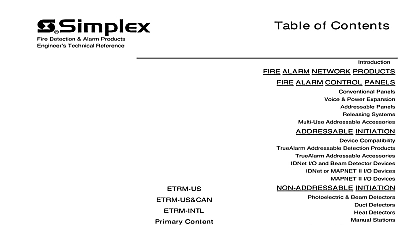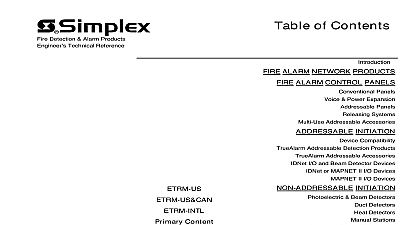Simplex ETRM-INTL, US and International Simplex Fire Alarm Data Sheet Binder Contents

File Preview
Click below to download for free
Click below to download for free
File Data
| Name | simplex-etrm-intl-us-and-international-simplex-fire-alarm-data-sheet-binder-contents-5432068719.pdf |
|---|---|
| Type | |
| Size | 161.98 MB |
| Downloads |
Text Preview
Fire Detection Alarm Products Technical Reference Content of Contents ALARM NETWORK PRODUCTS ALARM CONTROL PANELS Panels Power Expansion Panels Systems Addressable Accessories INITIATION Compatibility Addressable Detection Products Addressable Accessories I O and Beam Detector Devices or MAPNET II I O Devices II I O Devices INITIATION Beam Detectors Detectors Detectors Stations Station Wire Guards PERIPHERALS Addressable Appliances V O A V S V Appliances Speakers ACCESSORIES Annunciators Annunciators PC Annunciator Telephones Cabinets Chargers Holders Devices Protection Intrinsically Safe Devices Spare Parts Kits BINDER CONTENT REFERENCE when present CANADIAN PRODUCTS ADDITIONAL INTERNATIONAL PRODUCTS Fire Alarm Detection Products Engineer Technical Reference User are pleased to provide you with this Simplex Fire Alarm Products Engineer Reference information This binder provides a quick and easy source of technical data sheet information Fire and Detection Products Engineer Technical Reference binder contents be updated periodically For the most current information we recommend you regularly visit our online data sheet files data sheet files additional product information please visit the website home page at the Us section you can locate your local Simplex product who can provide personalized advice solutions and support tailored to application Control Panel Accessories 4120 Network TCP IP Physical Bridge Modules for 4100ES 4100U and 4100 Fire Alarm Control Panels Approved CSFM Listed with Simplex 4120 Network Simplex 4120 Network nodes using Ethernet LAN Local Area Network Converts 4120 network fire alarm communications into Control Protocol TCP using Internet IP formatting to connect between destination source IP addresses Network communications from any node to any other can pass through up to two 2 TCP IP links Network topologies include ring loop star hub of Network loops and combinations Hub Nodes act as data proxies allowing multiple Hub with Remote Nodes per Network loop refer to 3 for additional details Class X Style 7 pathway connections from Hub Nodes Remote Nodes are compatible with redundant LANs increased communications integrity Physical Bridge Interface Kit details TCP IP Physical Bridge Interface Kits are available for B Style 4 or Class X Style 7 pathways Each kit includes a physical bridge module NET232 converter s power and communications and mounting plate for the NET232 converter s Two media modules are required order separately as or fiber optic into Simplex 4100ES 4010ES and Legacy Series Fire Alarm Control Panels Mounting requires 2 slots 4 of module space one 2 for the TCP IP Physical Bridge and one 2 slot for NET232 converter mounting plate see page 3 for mounting information The TCP IP Physical Bridge connects to a standard 4120 network interface card ordered separately not already present Connection Flexibility TCP IP physical modules provide a network interface link that the flexibility of Simplex 4120 networks pass from the node network interface to the TCP IP module and then to a NET232 interface module powered by the local fire alarm panel Class X pathway connections use two modules for redundant Ethernet links Bridge Function Each physical bridge functions as a for its Remote Node to maintain overall network performance Types Connection options include linking 4120 network loops into one network creating hub to form star configuration systems and of these connections providing convenient flexibility Network with TCP IP Interconnection Hub Node to Star Connection Continued X Style 7 Hub Node Star Connections connecting from a Hub Node to Remote Nodes with X communications the connections function as a and secondary and only one would be in use at a typically the primary The secondary is monitored for by the bridge Size Considerations Each TCP IP Physical Bridge Interface Kit provides a between one fire alarm network node and the two kits are required for a complete bridge multiple kits are required for multiple connections Size Considerations The maximum TCP IP bridge links allowed per network twelve 12 this requires 24 Interface Kits The maximum number of fire alarm network nodes on a remote bridge loop is fifteen 15 For systems requiring more than 23 total nodes via TCP IP bridges to the main loop please system details with Simplex Product Sales Support Use of this product is subject to approval of the Local Authority Having Jurisdiction This has been approved by the California State Fire Marshal CSFM pursuant to Section of the California Health and Safety Code See CSFM Listing 7165 0026 0251 or 7165 0026 0369 4010ES for allowable values and or conditions concerning presented in this document It is subject to re examination revision and possible This product was not listed by UL or ULC as of document revision date MEA Acceptance is not applicable for this product category Additional listings may be contact your local Simplex product supplier for the latest status 5 2018 IP Address Requirements Utilization Reference Continued Addresses Before installation of the TCP IP Bridge Static or Reserved IP addresses and possibly will be required from the facility IT department will not be necessary if an Isolated Network is used your local IT department The facility IT will make the decision as to whether a Static or a address is required If a Static IP address or a Netmask is required those addresses will have to manually programmed into the NET232 module If a IP address is assigned the DHCP Dynamic Host Protocol server will automatically assign and the required addresses more information refer to Instructions 579 818 A contains a configuration worksheet that defines information required for the facility IT department Utilization Reference utilization is a measurement of how much is used during a specific time period Utilization is specified as a percentage of capacity For a network monitoring tool might state that network on an Ethernet segment is 30 meaning that 30 the capacity is in use Reference TCP IP physical bridge communicate with the fire alarm Network at bps and communicate with the LAN at 38.4 kbps To network utilization data a corporate network system at 512 kbps was measured with TCP IP physical modules connected Details The test conducted consisted of 150 points activated to repeatedly change state which resulted approximately 10,000 point state changes being over a 15 minute period Measured results are in the table below under Measured Peak Utilization Measured Average Utilization versus Data Rates Based upon the test results extrapolated Peak and Average for higher data rates was calculated and are in the table below These results illustrate that use of Physical Bridge Modules requires minimal LAN allocation note that calculated Worst Case information is upon a constant data transmission condition which not be a normal fire alarm network communication but is presented for reference Utilization Reference Table Worst Utilization data kbps Worst Utilization data


